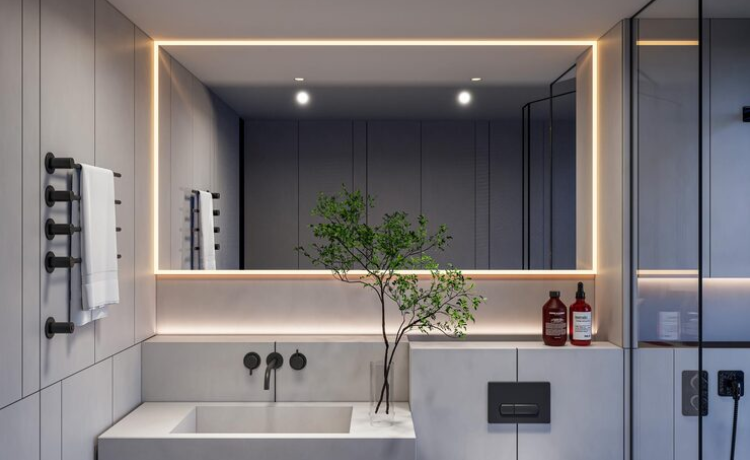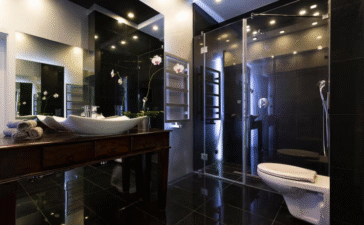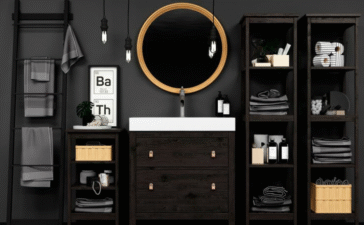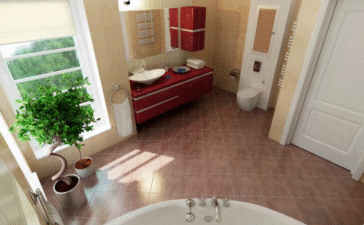When you flip the light switch in your bathroom each morning, you probably don’t think much about the fixtures casting light across your face. But bathroom sconce lights play a surprisingly vital role in how you experience that space. They determine whether your morning routine feels rushed and frustrating or calm and precise. They shape how your bathroom looks during quiet evening baths and busy weekday mornings alike.
Bathroom sconce lights are wall-mounted fixtures designed specifically for bathroom environments. Unlike overhead lighting that casts shadows downward, sconces provide side lighting that illuminates your face evenly. This makes them essential for tasks like applying makeup, shaving, or styling hair. Beyond their practical benefits, sconces add architectural interest to bathroom walls and help establish the room’s overall aesthetic.
The right sconce lighting transforms a purely functional bathroom into a thoughtfully designed space. Poor lighting, meanwhile, creates harsh shadows that make grooming difficult and can make even a beautifully renovated bathroom feel uninviting. This guide walks you through everything you need to know about selecting, positioning, and installing bathroom sconce lights that work beautifully in your home.
Understanding Bathroom Sconce Light Design Styles
Your bathroom’s design language should guide your sconce selection. The fixtures you choose communicate something about your aesthetic preferences and should harmonize with your existing decor rather than compete with it.
Modern Minimalist Bathroom Sconces
Modern minimalist sconces prioritize simplicity and function. These fixtures feature clean geometric shapes, often cylinders or rectangles, with finishes like brushed nickel, matte black, or polished chrome. The glass components tend toward simple tubes or spheres rather than elaborate shades. This approach to bathroom lighting works particularly well in contemporary spaces where every element serves a clear purpose.
Minimalist sconce designs gained significant traction after 2020, when homeowners increasingly embraced simplified interiors. These fixtures complement floating vanities, frameless mirrors, and other hallmarks of sleek bathroom design. The neutral finishes pair easily with various color schemes, making them versatile choices that age well as trends shift.
Vintage and Antique-Style Sconces
Vintage bathroom sconces draw inspiration from earlier eras, often featuring Edison bulbs, brass or bronze finishes, and traditional glass shades. These antique-style bathroom lights work beautifully in homes with period architecture or in modern spaces seeking a touch of historical warmth. The exposed filament bulbs popular in vintage designs create ambient bathroom lighting with character, though they typically consume more energy than modern alternatives.
Brass finishes have cycled back into popularity after years of dominance by cooler-toned metals. When selecting vintage-inspired sconces, consider how the finish will coordinate with your faucets, cabinet hardware, and towel bars. Consistency in metal finishes creates visual cohesion that makes bathrooms feel intentionally designed rather than randomly assembled.
Industrial and Art Deco Bathroom Lighting
Industrial sconces embrace raw materials and utilitarian aesthetics. These geometric light fixtures often feature exposed hardware, cage-style shades, and finishes that reference factories or warehouses. Art Deco designs, meanwhile, incorporate bold geometric patterns, stepped forms, and luxurious materials like frosted glass and polished metals.
Both styles work particularly well in urban lofts or bathrooms with high ceilings and dramatic architectural features. Industrial bathroom lighting pairs naturally with concrete, subway tile, and exposed plumbing, while Art Deco sconces complement marble, black-and-white color schemes, and glamorous fixtures.
Nature-Inspired Sconce Lighting
Wooden bathroom sconces and fixtures incorporating stone, bamboo, or other natural materials create spa-like lighting design. These nature-inspired bathroom lights help establish a calming atmosphere that encourages relaxation. The materials bring warmth and texture to spaces that might otherwise feel clinical or cold.
Natural material sconces require careful consideration of bathroom humidity levels. While many wooden sconces receive protective finishes, excessive moisture can still damage them over time. These fixtures work best in well-ventilated bathrooms or positioned away from direct water exposure. The eco-friendly bathroom lighting appeal of natural materials resonates with homeowners prioritizing sustainable design choices.
Positioning Bathroom Sconces for Optimal Performance
Even the most beautiful sconce produces disappointing results if installed incorrectly. Lighting placement tips make the difference between functional bathroom lighting and fixtures that merely occupy wall space.
Flanking Bathroom Mirrors with Sconces
Installing sconces on either side of your bathroom mirror creates the most flattering illumination for grooming tasks. This sconce mirror lighting configuration eliminates the harsh shadows that overhead lights cast under your eyes, nose, and chin. The fixtures should be positioned at eye level, typically 60 to 70 inches from the floor, depending on user height.
The ideal distance between sconces depends on mirror width. For most bathroom vanities, spacing sconces 36 to 40 inches apart provides balanced lighting without creating shadows in the center. If your mirror is particularly wide, you may need to adjust this spacing or consider adding a third light source above the mirror.
Above-Mirror Sconce Installation
Over-mirror sconces work well in larger bathrooms where wall space beside the mirror is limited. This configuration provides even bathroom lighting across the mirror’s full width. The fixture should be mounted 75 to 80 inches from the floor, positioning it just above the mirror’s upper edge.
This approach has limitations. Overhead lighting, even when positioned above the mirror, still casts some downward shadows. For this reason, combining an above-mirror sconce with supplementary lighting sources creates the most versatile bathroom lighting for tasks like precision grooming.
Task Lighting Versus Ambient Bathroom Lighting
Bathroom sconces can serve either task lighting or ambient lighting functions, depending on their positioning and the bulbs you choose. Task lighting focuses bright, directional light on specific areas where you need to see clearly. Ambient bathroom lighting provides general illumination that makes the entire space comfortable and navigable.
Most bathrooms benefit from layered lighting that combines both types. Sconces flanking the mirror serve as task lighting for grooming, while a ceiling fixture or additional sconces provide ambient light. This flexibility allows you to adjust brightness based on the time of day and your current needs.
Selecting Materials and Finishes for Bathroom Sconce Fixtures
The materials comprising your sconces affect both their appearance and their performance in the humid bathroom environment.
Glass Shades for Light Quality
Frosted glass sconces diffuse light softly, reducing glare and creating a gentler overall effect. This makes them excellent choices for ambient lighting or for bathrooms where you want a relaxed atmosphere. Clear glass bathroom sconces, by contrast, provide more direct illumination and showcase decorative bulbs like Edison-style filaments.
The thickness and texture of glass lighting shades influence how light distributes through space. Heavily textured or colored glass reduces light output, which may require higher-wattage bulbs to achieve adequate brightness. When evaluating glass sconces, consider both their appearance when illuminated and when switched off.
Metal Finishes for Durability and Style
Brushed nickel sconces remain popular for their versatility and their ability to hide water spots and fingerprints. Matte black sconces create dramatic contrast in bathrooms with white or light-colored walls and fixtures. Polished chrome offers a classic, reflective finish that coordinates with most bathroom fixtures, while brass and bronze finishes add warmth.
Metal finishes for bathroom lights should coordinate with other fixtures in the room. Mixing metals can work when done intentionally, but randomly combining finishes typically creates visual confusion. Consider photographing your existing fixtures and bringing those images when shopping for sconces to ensure compatible finishes.
Natural Materials for Organic Warmth
Stone bathroom lighting and wooden sconces introduce organic textures that soften the hard surfaces typically dominating bathrooms. These materials work especially well in bathrooms designed around natural or spa-inspired themes. Bamboo fixtures offer similar aesthetic benefits while being more naturally water-resistant than many woods.
When selecting sconces with natural materials, verify they have appropriate protective coatings and damp ratings for bathroom use. Even with proper finishes, these fixtures generally perform best in bathrooms with good ventilation and away from direct water spray.
Energy Efficiency and Smart Technology in bathroom sconce lights
Modern bathroom sconces incorporate technologies that reduce energy consumption and increase convenience.
LED Bathroom Sconces
LED bathroom fixtures use approximately 75% less energy than incandescent bulbs while lasting 25 times longer, according to the U.S. Department of Energy. This translates to significant savings over the fixture’s lifespan. LED technology also produces less heat, making bathrooms more comfortable during extended use.
Energy-efficient lighting comes in various color temperatures measured in Kelvins. Warm white LEDs (2700K-3000K) create cozy, relaxing light similar to traditional incandescent bulbs. Cool white (3500K-4100K) provides crisp, energizing light that many people prefer for morning routines. Daylight LEDs (5000K-6500K) most closely mimic natural outdoor light.
Smart Bathroom Sconce Features
Voice-controlled sconces integrate with systems like Amazon Alexa or Google Home, allowing you to adjust lighting without touching switches with wet or soapy hands. Wi-Fi enabled sconces can be scheduled to turn on before you wake up or to dim automatically in the evening. Some smart bathroom lighting systems adjust color temperature throughout the day to support natural circadian rhythms.
These connected lighting features appeal particularly to tech-forward homeowners and those with mobility limitations. The added convenience comes with higher upfront costs, but prices have decreased substantially as smart home technology has matured.
Choosing Appropriate Sconce Size and Scale
Bathroom dimensions and vanity size should guide your sconce selection to ensure proportional, effective lighting.
Compact Bathroom Lighting
Small bathroom sconces work best in powder rooms and compact bathrooms where space is limited. These fixtures typically measure 12 inches or less in height and project minimally from the wall. Single-bulb designs provide adequate illumination in tight spaces while avoiding visual clutter.
Space-saving light fixtures can still make strong design statements. Look for sconces with interesting shapes or finishes that add character without overwhelming the room. In very small bathrooms, consider using a single sconce above the mirror rather than flanking fixtures, which might feel cramped.
Large Bathroom Sconce Selection
Double vanity lighting requires more substantial fixtures or multiple sconces to properly illuminate the expanded counter space. Large bathroom sconces measuring 18 to 24 inches tall create appropriate visual weight in spacious bathrooms with tall ceilings. These fixtures prevent the lighting from disappearing against expansive walls.
When selecting large space sconces, ensure they provide sufficient light output to match their size. An oversized fixture with inadequate brightness creates an odd imbalance. Most larger bathrooms benefit from using multiple moderate-sized sconces rather than one or two enormous fixtures.
Avoiding Outdated Bathroom Lighting Trends
Design trends cycle through popularity, but some aesthetic choices age more gracefully than others.
Recognizing Overused Bathroom Lighting Styles
Exposed Edison bulbs flooded the market after 2015 and now appear in so many bathrooms that they’ve lost their distinctive appeal. Similarly, heavy brass finishes that were uncommon five years ago have become so prevalent that they’re beginning to feel dated. Overly ornate designs with excessive crystal details or elaborate scrollwork typically age poorly compared to simpler alternatives.
This doesn’t mean you should avoid all currently popular elements. Rather, consider which trends genuinely appeal to you versus which ones you’re drawn to simply because you see them everywhere. Bathroom lighting trends 2025 projections suggest continued movement toward minimalist designs, integrated technology, and sustainable materials.
Timeless Bathroom Sconce Designs
Future bathroom lighting will likely emphasize adaptability and longevity. Fixtures with replaceable components age better than those designed as disposable units. Classic geometric shapes typically outlast more elaborate designs. Neutral finishes coordinate with more decorative changes than trendy colors.
Modern bathroom sconce designs increasingly emphasize quality construction over novelty features. Well-made fixtures with solid materials and thoughtful engineering remain attractive and functional for decades, while cheaper alternatives often require replacement within a few years.
Practical Tips for Selecting Bathroom Sconces
Beyond aesthetics, several practical considerations ensure your sconces perform well in the bathroom environment.
Coordinating Sconces with Bathroom Decor
Your bathroom lighting style guide should consider the room’s overall design theme. Traditional bathrooms with classic elements like pedestal sinks and clawfoot tubs pair naturally with vintage or ornate sconces. Contemporary bathrooms with floating vanities and frameless showers call for modern, minimalist fixtures. Matching sconces with bathroom decor means considering not just the fixtures themselves but how they relate to mirrors, faucets, and cabinetry.
Bathroom lighting ideas work best when they address the entire space rather than focusing only on the vanity area. Consider how sconces will look from various angles and how their light will interact with tile, paint colors, and reflective surfaces.
Understanding Damp Ratings for Bathroom Safety
Damp-rated sconces are approved for use in bathrooms and other moisture-prone locations where they won’t be directly exposed to water spray. Wet-rated fixtures can withstand direct water contact, making them necessary for shower enclosures or areas immediately adjacent to tubs. Most bathroom vanity sconces require only damp ratings, as they’re positioned away from direct water exposure.
Using improperly rated fixtures creates safety hazards. Moisture can damage electrical components, create shock risks, and cause premature fixture failure. Always verify that sconces carry appropriate ratings before installation. Damp-rated light fixtures should indicate their rating on packaging or in product specifications.
Installation Height and Spacing Considerations
Proper sconce installation depends on user height, mirror size, and ceiling height. The standard recommendation of mounting sconces at 60 to 70 inches accommodates most adults, but households with particularly tall or short primary users should adjust accordingly. The fixtures should align roughly with the center of the mirror vertically.
Spacing between paired sconces typically ranges from 36 to 40 inches, though wider mirrors may require greater separation. Measure carefully before drilling to ensure balanced placement. If you’re replacing existing sconces, you may need to patch and repaint walls if the new fixtures don’t align with old electrical boxes.
Frequently Asked Questions
What is the ideal height to mount bathroom sconces?
Mount bathroom sconces at 60 to 70 inches from the floor, which typically aligns with eye level for most adults. This positioning eliminates shadows under the eyes and nose during grooming tasks. Adjust this height based on your household’s primary users. Taller individuals benefit from slightly higher placement, while shorter users need lower positioning for optimal face illumination.
How far apart should sconces be placed on either side of a mirror?
Space sconces 36 to 40 inches apart for most standard bathroom mirrors. This distance provides balanced lighting across the face without creating shadowy spots in the center. Wider mirrors may require greater spacing, while narrower mirrors need closer placement. Measure your mirror width and divide by three to find an approximate starting point for sconce placement.
Can I use regular light bulbs in bathroom sconces?
You can use any bulb that matches the sconce’s socket type and doesn’t exceed its maximum wattage rating. However, LED bulbs offer significant advantages for bathroom lighting. They use less energy, produce less heat, last dramatically longer than incandescent bulbs, and are available in various color temperatures to suit different preferences. Choose LED bulbs with appropriate color temperature for your needs: warm white for relaxing environments or cool white for task-oriented lighting.
What’s the difference between damp-rated and wet-rated bathroom sconces?
Damp-rated sconces can tolerate humidity and occasional moisture but shouldn’t be exposed to direct water spray. These fixtures work well for most bathroom vanity locations. Wet-rated sconces withstand direct water contact and are necessary for shower enclosures or areas immediately adjacent to bathtubs. Using improperly rated fixtures creates safety hazards and typically voids manufacturer warranties.
Should bathroom sconces point up or down?
The optimal sconce orientation depends on your specific lighting needs. Upward-facing sconces create ambient light by bouncing illumination off the ceiling, producing soft, diffused lighting throughout the bathroom. Downward-facing sconces provide more focused task lighting ideal for grooming activities. Many homeowners choose sconces with adjustable heads or that direct light both up and down for maximum flexibility.
How do I choose sconce finishes that won’t clash with existing bathroom fixtures?
Match metal finishes across all bathroom fixtures for the most cohesive appearance. If your faucets and cabinet hardware are brushed nickel, select sconces in the same finish. Alternatively, choose one accent finish (like matte black) and repeat it in two or three fixtures throughout the room. Avoid randomly mixing more than two metal finishes, which typically creates visual confusion rather than intentional contrast.
What color temperature works best for bathroom sconce lighting?
Most bathrooms benefit from color temperatures between 2700K and 3500K, which provide warm to neutral white light. Warm white (2700K-3000K) creates a relaxing atmosphere similar to traditional incandescent bulbs. Neutral white (3000K-3500K) offers slightly crisper light that many people prefer for morning grooming routines. Avoid very cool or daylight color temperatures above 4000K in bathrooms, as they can cast unflattering blue-toned light on skin.
Can I install bathroom sconces myself or do I need an electrician?
Installing sconces requires connecting electrical wiring, which many homeowners can manage with basic electrical knowledge and proper safety precautions. However, if you’re uncomfortable working with electrical systems, lack experience with wiring, or if your installation requires running new electrical circuits, hire a licensed electrician. Improper electrical work creates serious safety hazards including shock and fire risks. Most municipalities require electrical permits for new fixture installations.
How much light output do I need from bathroom sconces?
The American Lighting Association recommends 70 to 80 lumens per square foot for bathroom task lighting. For a typical bathroom vanity area of about 25 square feet, this translates to roughly 1,750 to 2,000 total lumens. If using two sconces, each should provide 875 to 1,000 lumens. Remember that these recommendations assume the sconces serve as primary task lighting; if you have additional ambient lighting, you may need less output from the sconces themselves.
What makes a sconce suitable for a small bathroom versus a large one?
Small bathrooms need compact sconces that don’t overwhelm the limited wall space. Look for fixtures 12 inches or shorter with minimal projection from the wall. Large bathrooms can accommodate more substantial sconces measuring 18 to 24 inches tall without the fixtures appearing out of proportion. Larger bathrooms often benefit from multiple light sources rather than relying solely on vanity sconces.
Are smart bathroom sconces worth the extra cost?
Smart sconces offer convenience features like voice control, scheduling, and dimming that appeal to many homeowners. If you already use smart home systems or have mobility limitations that make traditional switches inconvenient, the added cost may be worthwhile. However, if you’re primarily interested in energy efficiency, standard LED sconces provide most of those benefits without the premium pricing associated with smart features.
How do I clean and maintain bathroom sconces?
Clean glass shades monthly with a mixture of warm water and mild dish soap, then dry thoroughly to prevent water spots. Wipe metal finishes with a soft, damp cloth; avoid abrasive cleaners that can damage protective coatings. Turn off power before cleaning to avoid electrical shock. Replace burned-out bulbs promptly, as running fixtures with missing bulbs can stress remaining bulbs and electrical components.
Also Check: “bathroom wall sconces“
Creating Your Ideal Bathroom Lighting Environment
Selecting bathroom sconce lights requires balancing aesthetic preferences with practical considerations. The fixtures you choose determine how you experience your bathroom during rushed weekday mornings and relaxing evening baths. Well-positioned sconces eliminate the frustrating shadows that make grooming difficult while adding architectural interest to otherwise plain walls.
Start by assessing your bathroom’s existing design language and identifying which sconce style complements that aesthetic. Consider how the fixtures will coordinate with your mirrors, vanity, and other permanent elements. Verify that any sconces you’re considering carry appropriate damp ratings for bathroom use and produce sufficient light output for your needs.
Modern LED technology makes bathroom lighting more energy-efficient than ever while offering unprecedented control over color temperature and brightness. Whether you prefer the simplicity of traditional switches or the convenience of smart home integration, today’s sconces deliver performance that would have seemed impossible a decade ago. Take time to explore various options, measure carefully before installing, and select fixtures that will serve you well for years to come.












